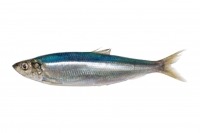
(Photo: Claude Nozères)
Atlantic Herring
Clupea harengus
This species has a small, elongate body with a rounded belly. They are silvery with dorsal colouration ranging from blue to greenish-blue. They grow to a maximum of 43 centimetres and 0.7 kilograms.
Authority
Linnaeus, 1758
Classification Details
Phylum: Chordata (chordates); Subphylum: Vertebrata (vertebrates); Class: Actinopterygii (ray-finned fishes).
Habitat
Atlantic herring are an abundant, coastal, pelagic species, found on both sides of the Atlantic Ocean. In the western Atlantic Ocean, their range extends from western Greenland south to Cape Hatteras, off North Carolina. They are a migratory species, which travel in schools to spawning and feeding grounds, and overwintering areas. Found in shallow, coastal waters and at depths of up to 200 metres in offshore waters. Fished commercially in the Bay of Fundy, including Passamaquoddy Bay, Gulf of St. Lawrence, southwest Nova Scotia, and off the western and eastern coasts of Newfoundland.
Diet
Younger herring feed on phytoplankton (microscopic plants). Adults consume zooplankton (microscopic animals), including copepods, krill, fish eggs, and mollusc and fish larvae. They use several methods of feeding. One is to detect prey by sight and target and attack them. The other is to filter them out of the water using their long, well-developed gill rakers. They follow the vertical migrations of zooplankton, which remain in deeper water during the day and travel to the surface at night to feed.
Reproduction
Sexes are separate. Most can reproduce by age five and can live up to 12 years. Spawning occurs from April to November. Fertilization is external, with males and females releasing large numbers of eggs and milt (sperm) into the water. Fertilized eggs attach to substrates such as rock, cobble, and seaweed, forming dense carpets on the ocean bottom. Very few eggs survive due to heavy predation by other fish. Those that do, hatch into the larval stage. Larvae are planktonic, relying mostly on currents for movement through the water. They are slender and transparent with no scales. The larvae will change to juvenile herring called brit, which more closely resemble adult fish. Their bodies develop scales, and they are flatter and silvery in colour. These juveniles will grow into adult herring.
Fun Facts
Herring are much more abundant than any other fish in the Quoddy Region. Juvenile herring (referred to as sardines) are collected using herring weirs in shallow water and purse seines in deeper water. They are transported for canning to one of the largest canning facilities in the world, located in Black’s Harbour, New Brunswick. The roe (eggs) are a delicacy in Japan known as kazunoko, a popular Japanese New Year’s dish.
Herring are critical in the Quoddy region food chain: many species of fish, birds, and marine mammals rely on the herring as food. These include the harbour porpoise, seals, and minke and humpback whales.
References
CBC. One of the largest sardine-canning factories in the world is in Blacks Harbour, N.B. https://www.cbc.ca/2017/we-are-the-best/one-of-the-largest-sardine-canning-factories-in-the-world-is-in-blacks-harbour-n-b-1.4284071 Accessed online 20 January 2020.
FAO. Species Fact Sheets – Clupea harengus. FAO FishFinder. http://www.fao.org/fishery/species/2886/en Accessed online 20 January 2020.
Froese R and Pauly D (2019) FishBase. Clupea harengus, Atlantic herring. https://fishbase.ca/summary/Clupea-harengus.html Accessed online 20 January 2020.
NOAA. Atlantic Herring. Herring Biology: Ecology. https://www.fisheries.noaa.gov/species/atlantic-herring Accessed 20 online January 2020.
Scattergood LW, Tibbo SN (1959) The herring fishery of the northwest Atlantic. Fisheries Research Board of Canada.
Scott WB and Scott MG (1988) Atlantic fishes of Canada. Canadian Bulletin of Fisheries and Aquatic Sciences 219, 731p.
The Japan Times. New Year’s salted herring roe sells for record ¥100,000. https://www.japantimes.co.jp/news/2016/11/22/national/new-years-salted-herring-roe-sells-record-%C2%A5100000/#.XiYxXMhKg2w Accessed online 20 January 2020.
Van Guelpen L, Pohle G, Vanden Berghe E and Costello MJ (2005) Marine Species Registers for the North Atlantic Ocean. World Wide Web electronic publication. http://www.vliz.be/vmdcdata/narms/


